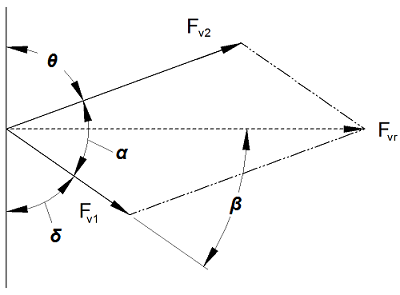Related Resources: calculators
Force Vector Addition Statics Equation and Calculator
Adding Forces by the Parallelogram Resultant of Two Forces Equation and Calculator
Law of Cosines, "Cosine Rule" for a Parallelgram (non-right angle triangle) to calculate the resultant force vector

Preview: Adding Forces by the Parallelogram Resultant of Two Forces Calculator
Resultant Load Vector:
Fvr = [ Fv12 + Fv22 - 2 Fv1 Fv2 cos ( 180 - α ) ) ]0.5
The angle of the resultant force vector and angle α can be found using the Law of Sine, "Sine Rule" for a Parallelgram (non-right angle triangle)
θ = 180 - α - δ
β = 1/ [ sin (Fv2 sin ( 180° - ( α ) / Fvr)
Where:
Fvr, Fv1, Fv2 = Force Vector quantity (lbf, N)
α, β, δ, θ = Angle as specified (deg)
Solving Statics Vector Problems
1. Identify which of the forces are the applied forces and which is the resultant. It is often helpful to write the vector equation which shows how the forces are related.
2. Draw a parallelogram with the applied forces as two adjacent sides and the resultant as the included diagonal. Alternatively, you can use the triangle rule, with the applied forces drawn in tip-to-tail fashion and the resultant extending from the tail of the first vector to the tip of the second
3. Indicate all dimensions. Using one of the triangles of the parallelogram, or the triangle constructed according to the triangle rule, indicate all dimensions whether sides or angles, and determine the unknown dimensions either graphically or by trigonometry. If you use trigonometry, remember that the law of cosines should be applied first if two sides and the included angle are known
Reference:
Vector Mechanics for Engineers, Beer, Johnson, Mazurek, Eisenberg Edition 9